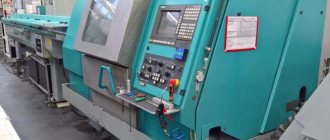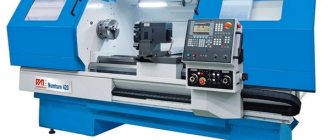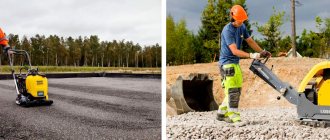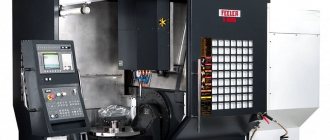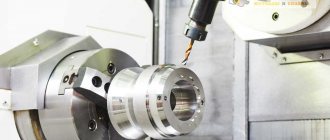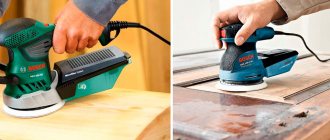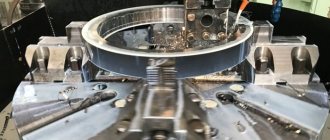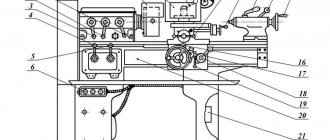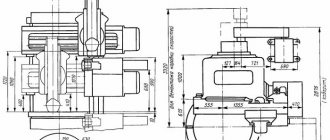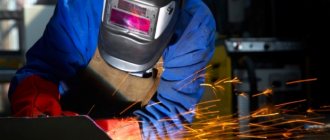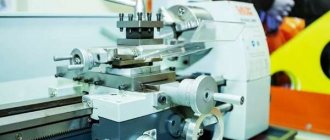Turning and milling machines
This is not a small machine, but a real center. Now such devices are produced with a huge number of capabilities and small compactness. This makes it possible to install a CNC router even in a standard garage.
They can be automated, semi-automatic or manual. Separately, it is worth mentioning about devices working on metal, which are equipped with numerical program control.
See also: Metal turning tools
CNC turning and milling machines
Numerical control makes machine tools automated and helps to accurately process a wide variety of workpieces. CNC metal cutting machines have great advantages compared to manually controlled analogues:
- Performance is an order of magnitude higher, which is important
- Increased precision is used, which is especially important when producing small and precise parts.
- The ability to apply modern information technologies when switching to other types of parts.
- Preparation for the process takes place in the engineering field of work.
- They serve for a long time and reliably.
- They are economical in resource consumption, which is very important for a large enterprise.
- Easy to use and maintain.
Also, such machines are distinguished by ergonomic design. Using such machines you can process long and flat parts.
Types of CNC turning and milling equipment
The production currently produces several types of milling machines:
- standard device;
- with a counter spindle;
- with an antinodal center;
- with the presence of a C-axis.
Each of the machine subtypes has its own technological differences. Modern standard machines can not only mill, but also drill holes in metal products. However, the revolver of such machines is inactive, and therefore the productivity is low.
The turning-milling processing machine does not have such problems, since it is equipped with a milling head with a landing end in the form of a variety of types of cones. The presence of such heads allows you to install special cutters on the equipment. This significantly expands the processes that can be performed with metal on such equipment:
- countersinking;
- drilling;
- chamfers, as well as grooves on workpieces;
- processing actions at the ends;
- deployment;
- thread cutting.
A special jig is also used to hold the square shank or a special cutting tool. There is also a special mechanism that is responsible for replacing tools in a CNC turning and milling machine. This device is called a changer.
Such complex installations are necessary in enterprises where highly complex metal parts of varying precision and complexity are manufactured. Using this equipment, it is possible to alternate milling with turning many times.
This is interesting: Heat treatment of metal
Milling centers with counter spindle and C-axis
The presence of a C-axis is one of the first models of equipment with cutters on the centers of the first modifications.
There is a separate drive to impart torque to the main tool (drill or cutter). An automated device - a changer - is responsible for replacing tools.
All devices with a C-axis have one important operating function - to control the angle of inclination and rotation speed of the workpiece. The indexing accuracy in this case will be one thousandth of a degree.
With such mechanisms in place, a C-axis machining center can perform many more functions than a standard lathe:
- work on gears;
- operations with a milling cutter on worm gears;
- turning of crankshafts, as well as their production.
All these operations are performed by a device with a C-axis without any problems. This improves its performance.
But devices with a counter-spindle are a more advanced tool for working with milling cutters and turning equipment. The second spindle is mounted in place of the tailstock. The presence of a second spindle on the processing device provides the tool with enormous functionality. To make the tool much more efficient, it can be equipped with a second changer.
Main blocks and components of the machine
The very name “turning and milling machine” speaks of at least two of its elements. CNC implies the ability to control both the first and second without direct human participation. The device consists of several functional blocks common to all types of such equipment:
- Tool heads, the task of which, as in standardized machines, is to install conventional or autonomously driven equipment. Depending on the complexity of the device, their number of heads sometimes reaches up to ten.
- Different operations require specific equipment to perform. If in a conventional machine the cutter is changed by the worker himself, in a turning-milling installation a device called a tool changer is used for this. According to the program, he will replace the drill with a countersink and the cutter with a reamer.
- You cannot do without devices that remove shavings and sawdust from the processing area. In small and inexpensive metal cutting machines, they simply fall onto a tray, from where the turner or maintenance personnel sweep them away. On large lines capable of operating in automatic mode 24 hours a day, a special mechanism is used for this purpose, removing waste outside the machine.
- Since turning and milling work on metal is carried out at high speeds, the machine is provided with a cooling system.
In turning and milling machines, not water is used for these purposes, but coolant (cutting fluid). It not only reduces the temperature, but also improves the contact of the cutter with the metal, removes small sawdust, improving the quality of processing.
Coolant supply in some cases occurs under significant pressure, reaching tens of bars. The jet of liquid not only performs cooling, but instantly washes away the smallest crumbs of steel that appear during metalworking, ensuring high cutting accuracy.
Types and features of machines
Enterprises that perform metal work, both turning and milling, have different specifics. Accordingly, some people want more complex machines, while others want less sophisticated ones. In the most common configuration, we have a simple lathe, to which a milling head is added. All this is controlled by a relatively simple CNC. Today, such devices are purchased by small workshops and even individual craftsmen for domestic use.
More complex turning and milling installations have a so-called counter-spindle. In fact, this is an ordinary lathe, the only thing is that instead of its tailstock there is another front one.
A further complication of the machines will be the addition of a second tool changer, an additional head that performs metalworking. The number of additional devices reaches up to a dozen, and the number of tools used in processing a part exceeds one hundred items.
Control
The capabilities of a turning and milling machine for metal work with a CNC system are increased not only due to purely mechanical improvements and additions. This is largely achieved through software improvements. One of the main characteristics of CNC machines is the number of controlled coordinates. For one modern turning and milling installation it reaches 12. There is such an indicator as the number of simultaneously controlled coordinates. There are no more than 6 of these.
The movements of the working tools of a conventional lathe occur in only two coordinate axes. In mathematical software they are usually denoted by Z and X. The first is the axis of rotation of the part, the second is the movement of the cutter.
For turning and milling machines, the Y coordinate is added. In addition to these main axes, additional axes are used to indicate the movement of other working bodies. In complex machines, movement can occur in 12 directions, and in half of them simultaneously. Even the combination of rotation of the workpiece with the movement of the cutter, which gave birth to the lathe, created a fundamentally new quality of processing. Now imagine how much more complex a part a metal cutting machine can create, with six times more possible combinations.
Machining centers of the trading company TRENS
All installations of this company have one characteristic design - an inclined frame. As a result, the machines are very durable and rigid. With such a device it is easy to create the most accurate parts.
This brand has several metal-processing milling machines with different levels of equipment. The most popular and frequently used machining centers in large- and medium-scale production should be described.
SBL 300
One of the simple models that works on thread cutting, performs milling work, as well as complex manipulations. Despite the simplest operations performed, this device easily copes with all milling operations.
The spindle of this device is characterized by increased rigidity, strength and excellent reliability. Its advantage is the ability to work at high speeds for a long time.
Separately, it is worth mentioning the C-axis characteristics that affect torque. It is these characteristics that allow you to quickly change operating modes, which is necessary in modern production conditions.
All the advantages of this device were obtained thanks to disk-type fastening equipment.
SBL 500 A
This modern machine can easily process parts weighing up to a ton. The machine includes a counter-top pin, and a clear CNC system is easy to set up. The workpieces are fixed using hydraulic mechanisms.
A special feature of this mechanism is that it is possible to drill off-axis in one step.
SBL 700
This version of the machine is considered the most modern in its line. It is capable of processing stepped part and straight configuration material. In this case, the weight of the workpiece on the machine can increase to 2.5 tons. The operation of the entire device in the CNC system is described by 3 D programming.
The connection is made via Internet Protocol.
Features of XDNC50 CNC Lathe
| Characteristics | Name | Specifications | |||
| Main characteristics | Max. Machining above the bed | 530 mm | |||
| Max. Center length | 1000 mm | ||||
| Distance between spindle and tailstock | 1050 mm | ||||
| Dimensions | Max. Machining diameter on bed | 330mm(shaft type) | |||
| Max. Media Processing Diameter | 250 mm | ||||
| Max. Machining length from cam to tailstock | 830 mm | ||||
| Max. Through diameter | 80 mm | ||||
| Positioning accuracy | Motion accuracy, X axis | 0.006 mm | |||
| Motion accuracy, Z axis | 0.013 mm | ||||
| X Position Accuracy | 0.025 mm | ||||
| Z axis position accuracy | 0.03 mm | ||||
| Spindle center distances | Distance from spindle center to floor | 1030 mm | |||
| Characteristics Spindle | Diameter, spindle holes | 82 mm | |||
| Spindle taper shank inner diameter | 1:20/φ90 | ||||
| Spindle speed | Automatic 3 speed gears 34~2000rpm High:215~2000rpm, Mid:76~700rpm, Low:34~320rpm | ||||
| Characteristics of the headstock | Headstock type | Headstock Y-axis | |||
| Headstock range | ER25 (Ø2-Ø16) | ||||
| Headstock speed | 3000 rpm | ||||
| Distance between pasterns | 60 mm | ||||
| Engine characteristics | Main spindle | 7.5 kW | |||
| Headstock motor | 1.5 kW | ||||
| Engine front, headstocks along Y axis | 1.2 kW | ||||
| Z axis servo motor | 1.5 kW | ||||
| X axis servo motor | 1.2 kW | ||||
| Cooling pump motor | AYB - 0.115 kW | ||||
| Hydraulic Clamp Installation | Standard hydraulic. Clamp | Hydraulic. Clamp | 8 inches (manual)/(hydraulic) | ||
| Axes movement characteristics | X-axis travel speed | 4 m/min | |||
| Z axis speed | 8 m/min | ||||
| X-axis movement | 310 mm | ||||
| Z axis movement | 1020 mm | ||||
| Tailstock | Spout type | MT5 | |||
| Moving rear, headstock | 150 mm | ||||
| Moving the tailstock along the X axis | ±15 mm | ||||
| Turret performance | Turret type | 6-position turret | |||
| Tool change time: position /45 degrees /60 degrees | 2.8 seconds | ||||
| Overall dimensions of tools | Machining tools, diameter | 25×25 | |||
| Boring cutter | φ25 | ||||
| Replaceability of cutting inserts | No | ||||
| Steady rest center | Clamping range | ≤200mm | |||
| Limit dimensions | L×W×H | 3100mmx1260mm x 1600mm | |||
| Weight | Total weight | 2600 kg | |||
Machine structure and parameters
| Name | Country of origin | Brand | Note |
| Control device | China | GSK 988 | |
| Spindle servo motor | China | GSK 7.5kW | |
| Servo motor for X,Z axes | China | GSK | Tire type |
| Spindle | China | South | |
| Spindle bearings | China | HRB | Class P4 |
| Guide bearing | China | HRB | Class P4 |
| Guides | China | South | Solid rail |
| Ball screw | China | Hanjiang/bot | |
| Motor for rotating tools | China | GSK | |
| Clamping the chuck rotating the tool along the Y axis | China | ||
| Chuck | China | BillionChuan | Cartridge 250mm manual 3-jaw |
| Electric turret | China | Hongda | Electric, horizontal, 6 position |
| Automatic lubrication | China | YERS | |
| Cooling system | China | Micro Special | |
| Hazard warning lamp | China | 3 colorsledlight | |
| External handwheel | China | Guangzhou CNC |
Machining center 1728C
This is a common device that can perform several different functions:
- work with a drill directly straight and at the required angle;
- contour milling and standard method;
- sharpening and boring.
The required part is processed in the chuck or in its center. Precision during processing is ensured due to the features of the mechanisms:
- The main components are durable and resistant to vibration.
- The bearings in this device are highly accurate.
- Specific thermosymmetric elements help prevent deformation caused by temperature fluctuations.
- The numerical control system is reliable and adjusted to the latest technology.
This design helps process various parts with a diameter of up to 40 cm and a length of up to three meters.
Overview of other options for metal processing equipment
Turning and milling centers, which are produced in Taiwan under the company name TAKISAWA . With a large number of functions performed, this brand has an affordable price.
Important. There are several series, many of which are used in the production of automobiles and aircraft .
The most popular machines of these models have 2 turning units and one milling unit. The presence of a turret head guarantees high precision in processing the workpiece.
The Spanish company uses its devices to produce metal parts with an increased level of precision, as well as for their subsequent adjustment.
The main features of the brand of machines from the Spanish company GMTK:
- Tool changers.
- Hydrostatic guide.
- Temperature control function.
Spanish machines perfectly process metal parts that require special precision.
There are several other imported organizations that are successful in the production of turning and milling machines.
VICTOR
The Taiwanese company has been operating in the tool market for over 70 years. The machines are distinguished by their quality and a large number of components. For the production of machines, the company uses a special grade of cast iron.
MULTICUT
The Czech manufacturer produces high-quality modern equipment with high-tech CNC systems. Often these machines have a second spindle or tailstock.
Such a device easily processes a part in 5 coordinates. The tool grinds, sharpens, and also performs many other operations on metal parts.
How does the counter spindle work?
Installing a counter-spindle (counter-spindle) S2 with a full C axis allows you to process the part from the reverse side (drilling, milling, perforation) without additionally moving the part into the machine, therefore saving the time required to completely process the part. This capability allows the processing of parts of increased complexity and precision.
A typical application of a counter spindle is the manufacture of shafts and end machining on both sides.
The spindle and counter spindle of the turning machining center are synchronized to ensure high precision workpiece positioning, which improves the precision of heavy machining.
Turning and milling machines with a sub-spindle may have the letter “S” in their name.
CNC lathe with Y axis and counter spindle
